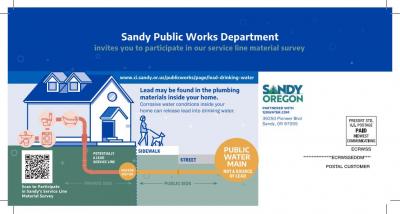Lead in Drinking Water
OCTOBER 2024 UPDATE: After a year and a half investigation and research on our water service lines, the City can now verify that there is NO lead in our water service line materials. Using the OHA guidelines, Sandy has completed a statistical analysis of the unknowns in the inventory. This involved inspecting over 20% of unknowns at random to determine that no lead services can be found in Sandy. City crews inspected more than double this number and found no lead service lines. City crews will continue to inspect unknown services until this inventory has all been inspected.
Our methodology consisted of:
- On- Site Visual Inspections at the meter box
- Water vacuum Excavation
- Customer Self - Identification. We sent postcards to all the homes built prior to 1986 asking for assistance identifying their water lines.
- Mechanical Excavation
- Data from our Utility Billing and other retained records such as As-Built plans
__________________________
* How Do I Identify My Pipe Material
Questions & Concerns: nolead@cityofsandy.com
***Google Map Of Water Services That Need To Be Verified As Lead Free***
Did you know that the City of Sandy is required to sample for Lead and Copper in our water distribution system every 3 years? Lead was common in service line materials used in some parts of the country, but it has not been documented as an often-used material for water service in the Pacific Northwest. It was, however, used in plumbing fixtures which can leave traces of lead in drinking water.
In compliance with the Environmental Protection Agency (EPA) 2009 revision of the Lead and Copper Rule, the City's Lead and Copper sampling sites consist of single family structures with copper pipes with lead solder installed after 1982 (but before the effective date of Oregon's lead ban which was 1985) or contain lead pipes and /or that are served by a lead service line. In 1986, Congress banned the use of lead materials in plumbing but allowed existing pipes to remain in service.
Revised Lead and Copper Rule 2021
In December 2021, the EPA published the revised Lead and Copper Rule. A requirement of the updated rule is for water suppliers to create a public facing map of all service line and pipe materials within the city's service area. The City of Sandy currently has over 4,100 water services in our distribution system. This is a heavy lift for city staff, and given our limited resources, we are asking the community to help us comply with the new rule. City staff are confident that there are no lead service lines in our service area. We need your help in documenting service lines and completing the map.
Please refer to our How to Identify Pipe Material section to help you determine what type of pipe material you have entering your house. The Interactive Links to Identifying Pipe Material section below lists interactive websites to help identify pipe materials Once you have identified your pipe materials, or if you already know your pipe material, please use the below email to submit the information to our Water Quality staff. If possible, please include three photographs of where your service line enters your house for staff t ouse in the case of a discrepancy. You can also send an email of your pipe material information and photographs to nolead@ci.sandy.or.us.
How Could Lead Get In My Water?
Water leaving the treatment plant and traveling through water mains is almost always free of lead. However, lead is sometimes present in lateral pipes connecting older homes to the water system, or in fixtures and home plumbing. Studies have shown that most lead in drinking water is the result of the corrosive action of water on home plumbing, and homes of a certain age are most susceptible. The City of Sandy adjusts the water chemistry at the treatment plant to minimize the possibility of lead dissolving into the water, but there are additional steps you can take at home. Sources of lead in home plumbing and fixtures include:
- Copper Pipe with Lead Solder
- Faucets and Fixtures
- Galvanized Pipe
- Lead Goose Necks and Pigtails that Connect your Pipes to the Water Meter
Health Effects of Lead
Exposure to lead in drinking water can cause serious health effects in all age groups. Infants and children can have decreases in IQ and attention span. Lead exposure can lead to new learning and behavior problems or exacerbate existing learning and behavior problems. The children of women who are exposed to lead before or during pregnancy can have increased risk of these adverse health effects. Adults can have increased risk of heart disease, high blood pressure, kidney, or nervous system problems. Click HERE for EPA's website where you can read more about the health effects of lead.
What We Do To Protect Your Water
There are multiple ways that we protect your water. The City of Sandy manages a robust Cross Connection program ensuring that connections such as irrigation systems and other potential health hazards are tested/inspected regularly. Water quality is another key to protecting your supply, through weekly, monthly and yearly samples we safeguard your water. The City of Sandy Water facilities are secured with fencing, site lighting and other security measures to ensure all access points to your drinking water are protected.
How To Reduce Lead In Your Drinking Water
If you have lead service lines or plumbing fixtures, there are steps you can take right away to reduce the possibility of lead in your water.
- Run the Tap Before Use - Lead levels are likely at their highest when water has been sittinng in the pipe for several hours. Clear this water from your pipes by running the cold water for several minutes, which allows you to draw fresh water from the main line. Please remember to be water wise and try not to waste water. You can use this water on house plants or to flush toilets.
- Clean Aerators - Aerators are small attachments at the tips of faucets which regulate the flow of water. They can collect small particles of lead in their screens. Its a good idea to remove your aerators at least monthly and clean them out.
- Use Cold Water for Drinking and Cooking - Always cook and prepare baby food with cold water, because the hot water dissolves lead more quickly, resulting in higher levels in water.
- Change out Old Fixtures - Plumbing regulations now stipulate that all fixtures must be manufactured lead-free. Consider installing new fixtures and /or pipes to eliminate sources of exposure.
- Filter the Water - Many home water filters are effective at removing lead. If you purchase a filter, make sure it is certified for lead removal and that you maintain properly. Find out more on filter certification at https://www.nsf.org/consumer-resources/articles/lead-drinking-water .
- Do Not Boil Water - Boiling water will not remove lead from water
How Do I Identify My Pipe Materials
Step 1 - Locating where the service line enters your house
This is typically found in the basement of crawl space and could also be located near the water heater or the washing machine. A shut off valve is installed on the pipe after the point of entry.
Identify a test area on the pipe between the point where it enters the building and the valve. If the pipe is covered or wrapped, expose a small area of metal.
Step 2 - Perform the scratch and magnet test (see directions in Step 3)
Scratch Test - Use a flat head screwdriver or a coin to perform a scratch test.
Magnet Test - Use a refrigerator magnet to perform the magnet test.
Step 3 - Identify the service line material
Each type of pipe will produce a different type of scratch, react differently to the magnet, and make a unique noise when tapped with your screwdriver or coin. Follow the instructions below to help you identify your service line material.
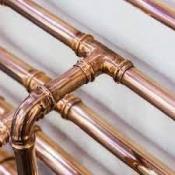
Copper or Brass
- Scratch Test - Scraped area is like copper penny
- Magnet Test - Magnet will not stick
- Tap Test - Tapping sound is metallic and ringing
- Threads - No Threads
- Copper pipes could be bluish in appearance
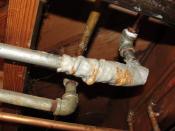
Galvanized Pipe
- Scratch Test - Scraped area remains dull silver or gray
- Magnet Test - Magnet will stick
- Tap Test - Tapping sound is metallic and ringing
- Threads - Has Threads
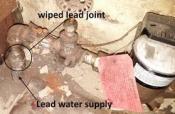
Lead Pipe
- Scratch Test - Scrapes easily to shiny bright silver
- Magnet Test - Magnet will stick
- Tap Test - Tapping sound is dull
- Threads - No threads
- Bulbous where connects to pipe of shutoff
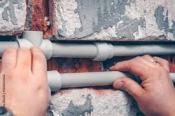
Plastic
- Scratch Test - Scrape feels dull and not metallic
- Magnet Test - Magnet will not stick
- Tap Test - Tapping sound is dull like plastic
- Threads - No threads
- Could be any number of colors (white, red, blue, clear)
Interactive Links to Help Identify Pipe Materials:
EPA - Protect Your Tap: A quick check for lead
NPR - Do you have Lead Pipes in your home
Additional Links to Help Identify Pipe Materials:
DC Water - Water Service Pipe Material Identification
EPA - Advice to Chicago Residents About Lead in Drinking Water
LSLR Collaborative - Identifying Service Line Materials
Videos to View:
American Water Works Association (AWWA) YouTube Video: Together, Let's Get the Lead Out

